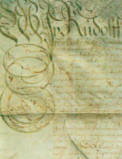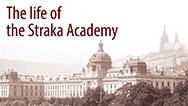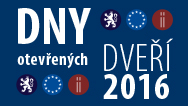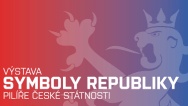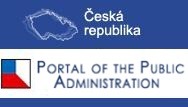Important days
9. 6. 2009
The 400th anniversary of Rudolf's Imperial Charter on Religious Freedom in the Kingdom of Bohemia
At the time, Prague was where the emperor resided and an important European metropolis. Czechs and their elites reflected themselves as a chosen nation, a new Israel, predestined to the renewal of all of Christianity. In this way, Czech messianism intermingled with Christian universalism, with the awareness of the special role of the Czech nation in the history of salvation. Among the main theological movers of the first phase of the Czech reformation were such people as Milíč of Kroměříž, Matěj of Janov, Jan Hus, Jakoubek of Stříbro or John of Rokycan, later the Utraquist archbishop and advisor to King George of Poděbrady (†1471). After the so-called Hussite Wars (1419-1434) a unique religious situation was created in Bohemia, one which had no equivalent in the Christian West: A Roman (Catholic) and Czech (Utraquist) church existed side by side, and after the destruction of the Tábor Church, the Unity of the Brethren joined their ranks. None of these church divisions were so strong politically that they became a hegemony in the Czech Kingdom, which caused the creation of a situation anomalous in Europe – an early "denominational pluralism" and a "tolerance born of necessity."
In the 16th century, the Czech Utraquist church and the Unity of the Brethren came into a mutually fertile interaction with European reformations. At the time, the Kingdom of Bohemia was one of the European countries with a large diversity of denominational beliefs and a large amount of mutual tolerance. The fundamentals of the so-called Peace of Augsburg (1555), were never valid here; denominational freedom was not a matter for authorities, but for individuals. Despite this, however, from a formal standpoint only the Czech Utraquist Church could exist alongside the Roman Catholic Church, protected by the so-called compacts as the law of the land. Denominational reality, of course, was already so different that representatives of non-Catholic estates themselves put forth an elimination of the compact from provincial privileges in the provincial assembly in 1567. Attempts at finding common denominational and religious-political platforms led to the writing of the so-called Bohemian Confession (Confessio Bohemica). Emperor Maximilian II (†1576) permitted the Czech provincial assembly at the time to also act on religious matters. The composition of a common denomination was entrusted to a special commission by the assembly made up of representatives of noblemen, knights and burghers. Two professors from the university in Prague, Pavel Přáza-Pressius and Matyáš Dvorský-Rozsypal, kept watch over their theological cohesion, and the thorough application of the brotherhood's teachings was overseen by theologist Jiřík Strejc. A leading Czech aristocrat, Bohuslav Felix Hasištejnský of Lobkowicz, was among the main political supporters of the emerging Bohemian Confession. In this way, a text was created that was inspired in both content and structure by the so-called Augsburg Confession (1530). At the same time it was a compromise between the Utraquist and Brethren theological traditions with the potential for the gradual integration of all Czech non-Catholic churches into a single countrywide church. The Confession was presented for the assessment of Emperor Maximilian on 18 May 1575. He later approved it orally and additionally under political pressure, so it was only a shaky support for the legal existence of non-Catholic churches in the country. The emperor was also in a precarious situation with the Roman church and the Czech Catholic estates, so he chose instead to ban the printing and further distribution of the Bohemian Confession.
The issue of religious freedom in the Kingdom of Bohemia and the validity of the Bohemian Confession became an issue for discussions in the provincial assembly in 1609. The Holy Roman Emperor and King of Bohemia, Rudolf II (†1612) was at the time under great political and military pressure from his brother, Matthias, who was the King of Hungary, the Archduke of Austria and also Rudolf's heir. In this complicated situation, Rudolf II searched for strategic allies. And on 4 July 1609, work began under his orders on a document that would ensure the freedom of religion for all Czech non-Catholics and ensure their political loyalty to the emperor. The text was conceived of according to a proposal by non-Catholic (evangelist) estate leaders and Emperor Rudolf II ceremonially signed and sealed it on 9 July 1609.
Evangelical estates were handed control over the so-called lower (Utraquist) consistories and the university in Prague, and a corps of 30 defenders were to oversee adherence to newly-confirmed freedoms. The first administrator of the renewed consistory - and with it the formal head of the unified Czech evangelists - was the priest and scholar Eliáš Šud of Semanín. As part of this alliance, which de iure created a unified evangelist church in the country, special considerations were to be taken with Czech (old) Utraquists, who insisted on the blessing of their priests in the so-called apostolic sequence, coexistence with the Roman church was also resolved with special documents (The Comparison, The Article).
But the unification of the Czech Utraquists, the Brethren and the Czech- and German-language Lutherans did not last long. The ensuing Czech religious-political crisis escalated into the pan-European tragedy of the 30 Years War (1618-1648), which was a catastrophe for the Kingdom of Bohemia. The loss of the Czech evangelical estates at White Mountain, near Prague (1620) was just a prelude at the beginning of fundamental changes in the structure of Czech society. Ferdinand II, the Hapsburg Holy Roman Emperor and King of Bohemia, issued a so-called Renewed Lands Dispensation, a new Czech constitution which cancelled the tradition until then of the estate-based state and turned the Kingdom of Bohemia into an absolute hereditary monarchy within the Hapsburg family. Roman Catholicism became the only allowed faith. This radical upset within cultural-political and religious parameters of Czech statehood was symbolically expressed also by the fact that Emperor Ferdinand II tore up the document of Rudolf's Imperial Charter and burned its seal.
But the unity of the denominational conglomerate of the Czech evangelical church could not be maintained even in exile, where thousands of families from all over Bohemia had to go due to persecution. Despite this, or precisely because of it, Jan Amos Comenius recalled the glorious period after the issuance of the Imperial Charter on Religious Freedom in his "History of the Heavy Tribulations of the Czech Church":
„Churches opened
Czechs rejoiced,
What Maximilian promised,
Rudolf deigned to fulfil.“
Text author: PhDr. Petr Hlaváček, Ph. D.
